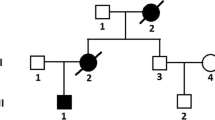Abstract
Barth syndrome (BTHS) is an X-linked disorder characterized by skeletal myopathy, neutropenia, growth delay, and cardiomyopathy. It is caused by mutations in the tafazzin gene (TAZ). Although early diagnosis is critical to prevent the progression of heart failure, this disease remains unrecognized when heart failure is not clinically significant. Here we report on a 13-year-old boy with no family history of BTHS who was diagnosed with the syndrome in the subclinical stage of heart failure. The clues to the diagnosis of BTHS in this patient were the findings of lipid storage myopathy in the skeletal muscle biopsy, elevated plasma brain natriuretic peptide, and the diagnosis of isolated noncompaction of the ventricular myocardium in echocardiography. Genetic studies of TAZ revealed a disease-causing mutation (p.Gly216Arg) in this patient. Physicians should be aware of the possibility of this disease and carry out genetic studies when it is considered.


Similar content being viewed by others
Abbreviations
- BTHS:
-
Barth syndrome
- BNP:
-
Brain natriuretic peptide
- COX:
-
Cytochrome c oxidase
- MR:
-
Magnetic resonance
- INVM:
-
Isolated noncompaction of the ventricular myocardium
- ACE-I:
-
Angiotensin-converting enzyme inhibitor
References
Barth PG, Scholte HR, Berden JA et al (1983) An X-linked mitochondrial disease affecting cardiac muscle, skeletal muscle and neutrophil leucocytes. J Neurol Sci 62(1–3):327–355
Bione S, D'Adamo P, Maestrini E et al (1996) A novel X-linked gene, G4.5. is responsible for Barth syndrome. Nat Genet 12(4):385–389. doi:10.1038/ng0496-385
Cantlay AM, Shokrollahi K, Allen JT et al (1999) Genetic analysis of the G4.5 gene in families with suspected Barth syndrome. J Pediatr 135(3):311–315
Hauff KD, Hatch GM (2006) Cardiolipin metabolism and Barth Syndrome. Prog Lipid Res 45(2):91–101. doi:10.1016/j.plipres.2005.12.001
Hsu DT (2010) Cardiac manifestations of neuromuscular disorders in children. Paediatr Respir Rev 11(1):35–38. doi:10.1016/j.prrv.2009.10.004
Ichida F, Tsubata S, Bowles KR et al (2001) Novel gene mutations in patients with left ventricular noncompaction or Barth syndrome. Circulation 103(9):1256–1263
Jenni R, Oechslin E, Schneider J, Attenhofer Jost C, Kaufmann PA (2001) Echocardiographic and pathoanatomical characteristics of isolated left ventricular non-compaction: a step towards classification as a distinct cardiomyopathy. Heart 86(6):666–671
Johnston J, Kelley RI, Feigenbaum A et al (1997) Mutation characterization and genotype-phenotype correlation in Barth syndrome. Am J Hum Genet 61(5):1053–1058. doi:10.1086/301604
Kelley RI, Cheatham JP, Clark BJ et al (1991) X-linked dilated cardiomyopathy with neutropenia, growth retardation, and 3-methylglutaconic aciduria. J Pediatr 119(5):738–747
Kuijpers TW, Maianski NA, Tool AT et al (2004) Neutrophils in Barth syndrome (BTHS) avidly bind annexin-V in the absence of apoptosis. Blood 103(10):3915–3923. doi:10.1182/blood-2003-11-3940
Neuwald AF (1997) Barth syndrome may be due to an acyltransferase deficiency. Curr Biol 7(8):R465–R466
Petersen SE, Selvanayagam JB, Wiesmann F et al (2005) Left ventricular non-compaction: insights from cardiovascular magnetic resonance imaging. J Am Coll Cardiol 46(1):101–105. doi:10.1016/j.jacc.2005.03.045
Spencer CT, Bryant RM, Day J et al (2006) Cardiac and clinical phenotype in Barth syndrome. Pediatrics 118(2):e337–e346. doi:10.1542/peds.2005-2667
Steward CG, Newbury-Ecob RA, Hastings R et al (2010) Barth syndrome: an X-linked cause of fetal cardiomyopathy and stillbirth. Prenat Diagn 30(10):970–976. doi:10.1002/pd.2599
Sweeney RT, Davis GJ, Noonan JA (2008) Cardiomyopathy of unknown etiology: Barth syndrome unrecognized. Congenit Heart Dis 3(6):443–448. doi:10.1111/j.1747-0803.2008.00226.x
Takeda A, Sudo A, Yamada M et al (2011) Barth syndrome. Eur J Pediatr (in press)
Conflict of interest
The authors declare that they have no conflict of interest nor any financial relations with the sponsoring organization.
Author information
Authors and Affiliations
Corresponding author
Rights and permissions
About this article
Cite this article
Takeda, A., Sudo, A., Yamada, M. et al. Barth syndrome diagnosed in the subclinical stage of heart failure based on the presence of lipid storage myopathy and isolated noncompaction of the ventricular myocardium. Eur J Pediatr 170, 1481–1484 (2011). https://doi.org/10.1007/s00431-011-1576-5
Received:
Accepted:
Published:
Issue Date:
DOI: https://doi.org/10.1007/s00431-011-1576-5




